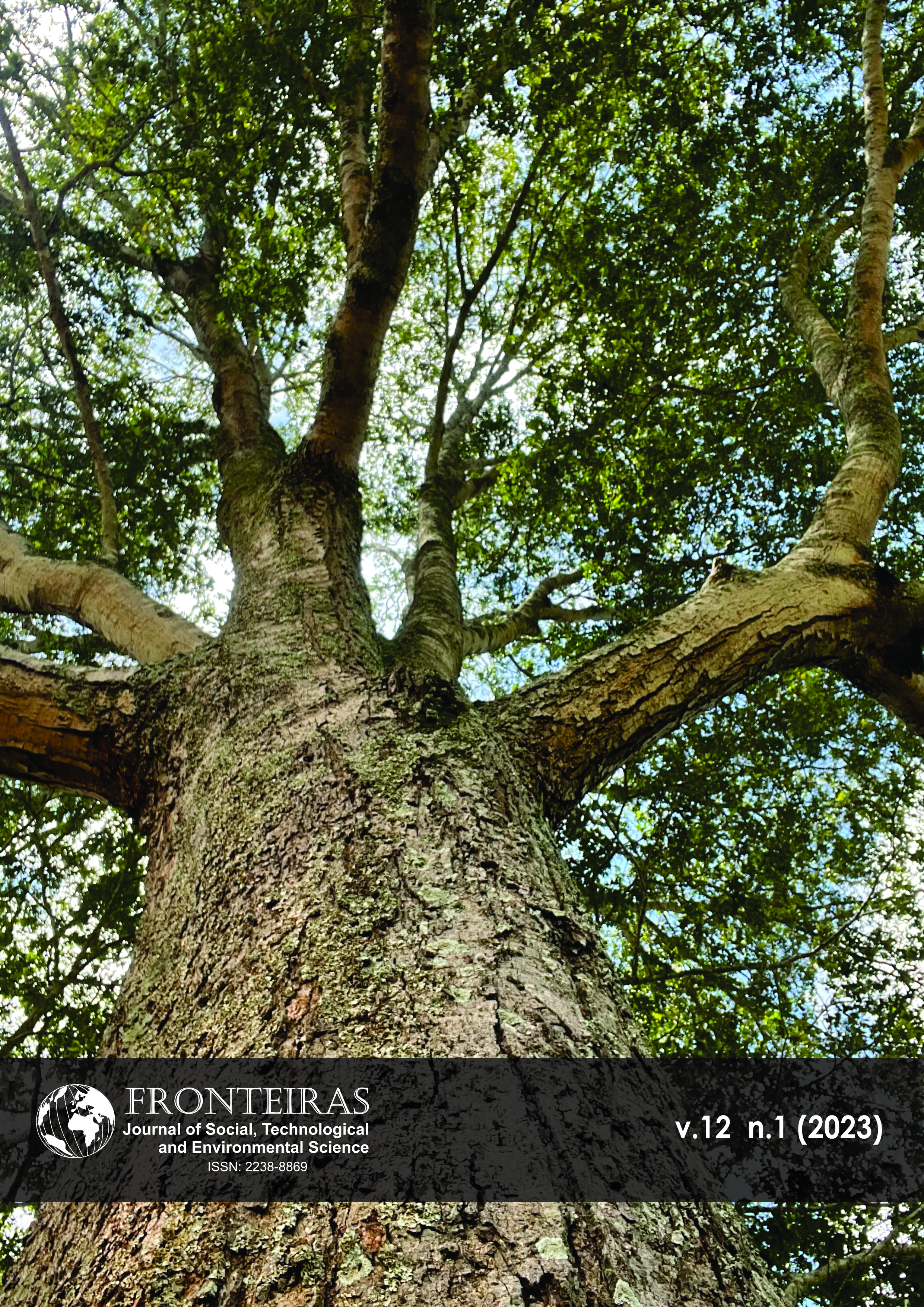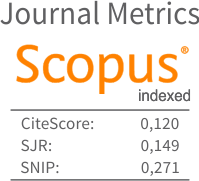Evaluation of Euphorbia tirucalli L. Immunomodulatory and Antitumor Activity
DOI:
https://doi.org/10.21664/2238-8869.2023v12i1.p56-70Palavras-chave:
Euphorbia tirucalli L, aveloz, tumor de Ehrlich, imunomodulaçãoResumo
Euphorbia tirucalli L. é empregado popularmente para o tratamento de diversas patologias, inclusive o câncer. O objetivo deste trabalho foi avaliar o efeito do extrato bruto da planta sobre o desenvolvimento do tumor sólido de Ehrlich (EHR) e sobre o sistema imunológico. O extrato foi preparado com as partes aéreas da planta maceradas com etanol 80% (1:10 g/v, 15 dias). A análise do desenvolvimento tumoral, em camundongos Swiss (n=10; machos) inoculados subcutaneamente com 10⁶ células EHR e tratados (via intragástrica, diariamente) com o extrato (33,33, 67 ou 133,34 mg kg-1) ou solução salina (0,5% etanol) durante 30 dias, demonstrou que o tratamento não apresentou efeito tóxico e não reduziu o crescimento do tumor, sendo o extrato de 67 mg kg-1 o que apresentou o menor valor da massa tumoral. A atividade imunomoduladora foi avaliada em camundongos swiss (n = 8; machos), portadores do tumor ou não, e tratados com 67 mg kg-1 do extrato, nas mesmas condições, durante 7 e 14 dias. A linfoproliferação, atividade NK e a produção de IL-12, TNF-a, IFN-y e IL-10 não apresentaram diferença significativa entre os grupos, mas a produção de IL-4 foi reduzida no grupo Aveloz e Aveloz + EHR, aos 7 e 14 dias, em comparação aos controles. Concluímos que o extrato não é tóxico, porém não foi capaz de inibir o desenvolvimento tumoral, e a sua ação imunomoduladora foi concentrada na modulação da IL-4.
Referências
Berman B. 2012. New developments in the treatment of actinic keratosis: focus on ingenol mebutate gel. Clinical, Cosmetic and Investigational Dermatology. 5: 111–122.
Bessa G, Melo-Reis PR, Araújo LA, Mrué F, Freitas GB, Brandão ML, Silva Júnio NJ. 2015. Angiogenic activity of látex from Euphorbia tirucalli Linnaeus 1753 (Plantae, Euphorbiaceae). Brazilian Journal of Biology. 75: 752-758.
Brunetti RL, Paz DPA, Fonseca IIM, Nagamine MK, Mori CMC, Grande MPD, Queiroz-Hazarbassanov N, Salles-Gomes COM, Dagli MLZ, Hernandez-Blazquez FJ. 2019. Inhibitory effects of Euphorbia tirucalli látex on murine B16/F10 melanoma cells and lung metastasis. Molecular and Clinical Oncology. 11: 511-516.
Choene M, Motadi L. 2016. Validation of the antiproliferative effects of Euphorbia tirucalli extracts in breast cancer cell lines. Molecular cell Biology. 50: 115-128.
Duong TH, Beniddir MA, Genta-Jouve G Nguyen HH, Nguyen DP, Nguyen TAT, Mac DH, Boustie J, Nguyen KPP, Chavasiri W, Pogan PL. Fitoterapia. 135: 44-51.
Dutra RC, Campos MM, Santos ARS, Calixto JB. 2016. Medicinal plants in Brazil: pharmacological studies, drug discovery, challenges and perspectives. Pharmacological Research. 112: 4-29.
Ernst M, Grace OM, Saslis-Lagoudalis CH, Nilsson N, Simonsen HT, Ronsted N. 2015. Journal of Ethnopharmacology. 176: 90-101.
Feitosa IB, Mori B, Teles CBG, Costa AG. 2021. What are the immune responses during the growth of Ehrlich’s tumor in ascitic and solid form? Life Sciences. 264: 118578.
Filho ENS, Santos OJ, Filho AKDB, Rocha AA, Silva RC, Santos RHP, Santos RAP. 2013. Evaluation of the use of raw extract of Euphorbia tirucalli L. in the healing process of skin wounds in mice. Acta Cirúrgica Brasileira. 28: 716-720.
Franco-Salla GB, Prates J, Cardin LT, Santos ARD, Silva Jr WA, Cunha BR, Tajara EH, Oliani SM, Rodrigues-Lisoni FC. 2016. Euphorbia tirucalli modulates gene expression. In larynx squamous cell carcinoma. BMC Complementary and Alternative Medicine. 16: 136.
Gahamanyi N, Munyaneza E, Dukuzimana E, Tuyiringire N, Pan CH, Komba EVG. 2021. Ethnobotany, ethnopharmacology, and phytochemistry of medicinal plants used for treating human diarrheal cases in Rwanda: a review. Antibiotics. 10: 1231.
Ibrahim EH, Kilany M, Mostafa OMS, Shaker KH, Alshehri M, Alsyaad KM, Alshehri A, Khan KA, Qasim M, Kotb N, Alahmari AS, Ghramh HA, Dajem SM. 2019. TH1/TH2 chemokines/cytokines profile in rats treated with tetanus toxoid and Euphorbia tirucalli. Saudi Journal of Biological Sciences. 26: 1716-1723.
Khaleghian A, Riazi GH, Ghafari M, Rezaie M, Takahashi A, Nakaya Y, Nazari H. 2010. Effects of inganen anticancer properties on microtobule organization. Pakistan Journal of Pharmaceitical Sciences. 23(3): 273-278.
Le NTM, Cuong DX, Thinh PV, Minh TN, Manh TD, Duong TH, Minh TTL, Oanh VTT. 2021. Phytochemical screening and evaluation of antioxidant properties and antimicrobial activity against Xanthomonas axonopodis of Euphorbia tirucalli extracts in Binh Thuan Province, Vietnam. Molecules. 26: 941.
Li Z, Wu Y, Wang C, Zhang M. 2019. Mouse CD8+NKTlike cells exert dual cytotoxicity against mouse tumor cells and myeloid-derived suppressor cells. Cancer Immunology, Immunotherapy. 68: 1303-1315.
Liezmann C, Stock A, Peters EMJ. 2012. Stress induced neuroendrocrine-immune plasticity. Dermato-Endocrinology. 4: 271-279.
Lin MW, Lin AS, Wu DC, Wang SSW, Chang FR, Wu YC, Huang YB. 2012. Euphol from Euphorbia tirucalli selectively inhibits human gastric cancer cell groth through the induction of ERK1/2-mediated apoptosis. Food and Chemical Toxicology. 50: 4333-4339.
Lin Z, Chen L, Qin Z. 2009. Paradoxical roles of IL-4 in tumor immunity. Cellular & Molecular Immunology. 6(6):415-422.
Llanes-Coronel DS, Gámez-Díaz LY, Suarez-Quintero LP, Páez LJ, Torres F, Echeverri F, Ponte-Sucre A, Patiño PJ, Trujillo-Vargas CM. 2011. New promising Euphorbiaceae extracts with activity in human lymphocytes from primary cell cultures. Immunopharmacology and Immunotoxicology. 33(2): 279-290.
Machado MM, Oliveira LFS, Zuravski L, Souza R, Fischer P, Duarte JÁ, Rocha MO, Güez CM, Boligon AA, Athayde ML. 2016. Evaluation of genotoxic and cytotoxic effects of hydroalcoholic extract of Euphorbia tirucalli (Euphorbiaceae) in cell cultures of human leukocytes. Annals of the Brazilian Academy of Sciences. 88: 17-28.
MacNeil A, Sumba OP, Lutzke ML, Moormann A, Rochford R. 2003. Activation of the Epstein-Barr virus lytic cycle by the latex of the plant Euphorbia tirucalli. British Journal of Cancer. 88: 1566-1569.
Mannucci S, Luzzi A, Carugi A, Gozzetti A, Lazzi S, Malagnino V, Simmonds M, Cusi MG, Leoncini L, Bosch CAVD, Falco GD. 2012. EBV reactivation and chromosomal polysomies: Euphorbia tirucalli as a possible cofactor in endemic Burkitt lymphoma. Advances in Hematology. 2012: 11 pages.
Martins CG, Appel MH, Coutinho DSS, Soares IP, Fischer S, Oliveira BC, Fachi MM, Pontarolo R, Bonatto SJR, Fernandes LC, Iagher F, Souza LM. 2020. Consumption of látex from Euphorbia tirucalli L. promotes a reduction of tumor growth and cachexia, and immunomodulation in Walker 256 tumor-bearing rats. Journal of Ethnopharmacology. 255: 112722.
Milhm ACP, Bonet LFS, Aiub CAF, Junior CLS. 2022. Biochemical characterization and phytotoxic activity of protein extract from Euphorbia tirucalli L. Journal of Ethnopharmacology. 285: 114903.
Mirlekar B. 2022. Tumor promoting roles of IL-10, TGF-b, IL-4, and IL-35: its implications in cancer immunotherapy. SAGE Open Medicine. 10: 1-15.
Morris SC, Orekhova T, Meadows MJ, Heidorn SM, Yang J, Finkelman FD. 2006. IL-4 induces in vivo production of IFN-g by NK and NKT cells. The Journal of Immunology. 176: 5299-5305.
Naume B, Gately MK, Desai BB, Sundan A, Espevik T. 1993. Synergistc effects of interleukin 4 and interleukin 12 on NK cell proliferation. Cytokine. 1: 38-46.
Oliveira LFS, Fuentefria AM, Klein FS, Machado MM. 2014. Brazilian Journal of Microbiology. 45: 1349-1355.
Palharini JG, Richter AC, Silva MF, Ferreira FB, Pirovani CP, Naves KSC, Goulart VA, Mineo TWP, Silva MJB, Santiago FM. 2017. Eutirucallin: a lectin with antitumor and antimicrobial properties. Frontiers in Cellular and Infection Microbiology. 7: 9 pages.
Paz DPA, Nagamine MK, Grande MPD, Leite JVP, Sobreira FMG, Bacchi EM, Dagli MLZ. 2020. Inhibitory effects of Euphorbia tirucalli Lineu (Euphorbiaceae) diluted látex on human and canine melanoma cells. Evidence-based Complementary and Alternative Medicine. 4093206, 5 pages.
Santos OJ, Carvalho-Júnior FF, Sauaia-Filho EN, Santos RHP, Santos RAP, Barbalho WG. 2013. Gastric healing process with raw extract of Euphorbia tirucalli L.: study in rats. ABCD Arquivos Brasileiro Cirurgia Digestiva. 26(4): 256-259.
Santos OJ, Filho ENS, Nascimento FRF, Junior FCS, Fialho SEM, Santos RHP, Santos RAP, Serra ICPB. 2016. Use of raw Euphorbia tirucalli extract for inhibition of ascitic Ehrlich tumor. Revista Colégio Brasileiro Cirurgia. 43: 18-21.
Sarker MM, Zhong M. 2014. Keyhole limpet hemocyanin augmented the killing activity, cytokine production and proliferation of NK cells, and inhibited the proliferation of Meth A sarcoma cells in vitro. Indian Journal of Pharmacology. (46): 40-45.
Shlamovitz GZ, Gupta M, Diaz JA. 2009. A case of acute keratoconjunctives from exposure to latex of Euphorbia tirucalli (pencil cactus). The Journal of Emergency Medicine. 36: 239-241.
Silva ACP, Faria DEP, Borges NBES, Souza IA, Peters VM, Guerra MO. 2007. Toxicological screening of Euphorbia tirucalli L.: developmental toxicity studies in rats. Journal of Ethnopharmacology. 110: 154-159.
Silva RMRJ, Teixeira DF, Sampaio ALF, Leitão TCA. 2011. Analysis of in vivo activity of high dilutions of Euphorbia tirucalli L. in human melanoma cells. International Journal of High Dilution Research. 10(36): 183-193.
Silva VAO, Rosa MN, Miranda-Gonçalves V, Costa AM, Tansini A, Evangelista AF, Martinho O, Carloni AC, Jones C, Lima JP, Pianowski LF, Reis RM. 2018. Euphol, a tetracyclic triterpene, from Euphorbia tirucalli induces autophagy and sensitizes temozolomide cytotoxicity on glioblastoma cells. Investigational New Drugs. 15 pages.
Sojka DK, Plougastel-Douglas B, Yang L, Paqk-Wittel MA, Artyomov MN, Ivanova Y, Zhong C, Chase JM, Rothman PB, Yu J, Riley JK, Zhu J, Tian Z, Yokoyama WM. 2014. Tissue resident natural killer (NK) cells are cell lineages distinct from thymic and conventional splenic NK cells. Elife. 3: e01659.
Souza LS, Puziol LCP, Tosta CL, Bittencourt MLF, Ardisson JS, Kitagawa RR, Filgueiras PR, Kuster RM. 2019. Analytical methods to acess the chemical composition of an Euphorbia tirucalli anticancer latex from traditional Brazilian medicine. Journal of Ethnopharmacology. 237: 255-265.
Valadares MC, Carrucha SG, Accorsi W, Queiroz MLS. 2006. Euphorbia tirucalli L. modulates myelopoiesis and enhances the resistance of tumour-bearing mice. International Immunopharmacology. 6: 294-299.
Varricchio MCBN, Pereira C, Sales F, Gomes T, Daudt E, Aquino CL, Barbosa GM, Gomes N, Pyrrho AS, Hobaica PEM, Branco MC, Kuster R, Holandino C. 2008. Chronic toxicological effects of high diluted solutions of Aveloz (Euphorbia tirucalli L.) on healthy mice: a preliminary study. International Journal of High Dilution Research. 7(25): 174-178.
Wang L, Wang G, Yang D, Guo X, Xu Y, Feng B, Kang J. 2013. Euphol arrests breast cancer cells at the G1 phase through the modulation of cyclin D1, p21 and p27 expression. Molecular Medicine Reports. 8: 1279-1285.
Downloads
Publicado
Como Citar
Edição
Seção
Licença
Esta revista oferece acesso livre imediato ao seu conteúdo, seguindo o princípio de que disponibilizar gratuitamente o conhecimento científico ao público proporciona maior democratização mundial do conhecimento.
A partir da publicação realizada na revista os autores possuem copyright e direitos de publicação de seus artigos sem restrições.
A Revista Fronteiras: Journal of Social, Technological and Environmental Science segue os preceitos legais da licença Creative Commons - Atribuição-NãoComercial 4.0 Internacional.


